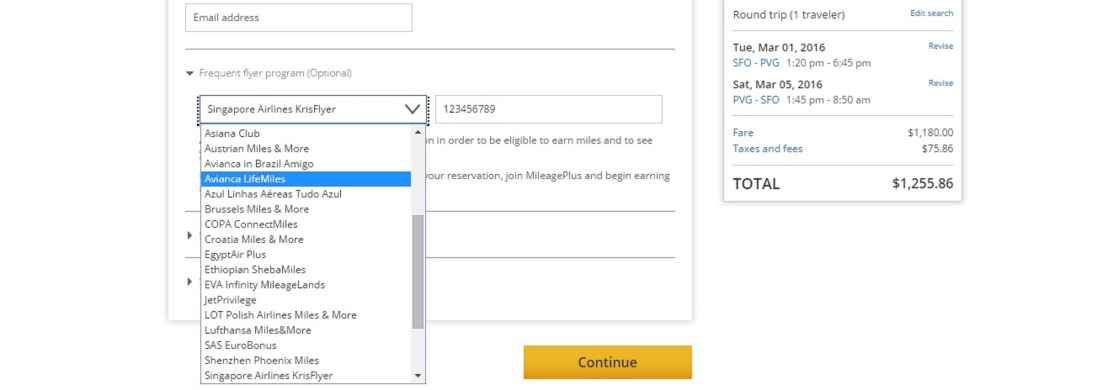
Before reading this page, I highly recommend you read my page on Airline Alliances and Partnerships, as it will make much of the below easier to understand.
For a while, I thought frequent flyer programs were only for business travelers and never bothered to sign up and earn miles. However, given the plethora of ways to supplement frequent flyer accounts with additional miles (which I’ll get to later), not choosing to earn miles on paid flights is like throwing away free money. That being said, most frequent flyer programs will take away your miles if you go a certain amount of time (usually 18 months) without any activity, though this often can be eliminated with a co-branded credit card with that airline.
Where and how to credit flights
As I’ve mentioned before, while frequent-flyer programs were designed to reward loyalty to a particular airline, you almost always have multiple options when deciding how you’re going to earn miles from a paid flight.
If the airline you’re flying belongs to one of the three major alliances, you can choose to earn miles on any airline in that alliance. However, you can also choose to earn miles on airlines that that airline partners with, whether or not it’s in that alliance.
This is an incredibly valuable resource for figuring out where to credit your flights.
Now, I realize that this can be a lot to wrap one’s head around. An easy strategy is to just credit your all flights to United, American, or Delta. However, while all the airlines used to operate on the relatively uncomplicated idea that you earn one mile for every mile you fly, the big three airlines in the U.S. (United, American, and Delta) have all recently switched to what’s known as revenue-based earning, where the amount of miles you earn for a flight correlates with how much money you spent on the flight. (American was the last holdout, but this change is set to take effect on March 21, 2016). This obviously rewards business travelers and people who spend a lot of money with an airline, but hurts people who find great deals. For example, in the past, if you were lucky enough to find a $500 roundtrip flight from San Francisco to Shanghai on United, then you would earn around 12,000 miles for that flight, the actual amount you flew. Now, unless you have elite status with United, you’ll earn five times the cost of your flight regardless of distance, meaning that a $500 roundtrip flight from San Francisco to Shanghai will earn you the same amount of miles (2,500) as a $500 roundtrip flight from San Francisco to Dallas.
The good news is that many other airlines still award miles based on distance flown. However this is often subject to the fare class that you book in. In short, a fare class refers to different pricing tiers at which an airline sells its tickets. A more in-depth explanation can be found here. However, for beginners, the important part isn’t knowing what your fare class means, but rather just the letter.
For example, the following round-trip flight to Shanghai from San Francisco on United is in fare class K (which means it’s a discounted economy ticket):

If I choose to earn United miles on this (and I don’t have any elite status with United), I’ll earn 6,280 miles, as they award you miles equals to five times the fare. Given that I’m actually flying over 12,000 miles though, there may be another option for earning more miles with another Star Alliance airline.
In particular, Singapore Airlines is often a favorite for United travelers since United changed their earning structure, given that Singapore Airlines will award 100% of miles flown for almost all fare classes (except N, the absolute lowest, heavily-discounted fare class). So if I were to enter my Singapore Airlines KrisFlyer number (the name of their frequent flyer program) when making this reservation, I would earn over 12,000 miles on Singapore Airlines. Of course, how valuable 12,000 KrisFlyer miles are on Singapore Airlines and what you can do with them is also another factor to consider (in particular, they are known for levying very high taxes and fees on award redemptions), but that’s for another post. Recently, I’ve been crediting my paid United flights (which I actually got for free with the use of my American Express cards) to Air Canada’s Aeroplan program, as I already had existing miles with them.
Below is how one would select the frequent flyer program when making a United reservation online; most airlines offer a similar interface.

Help, I forgot to enter a frequent flyer number (or entered the wrong number) when making a reservation!
While it’s always best to enter your frequent flyer number when making a reservation, sometimes you will forget (or sometimes if you make a reservation while already logged into your frequent flyer account, it will automatically associate that frequent flyer account with your reservation.
The good news is that you don’t have to decide before your flight where you’re going to credit your miles (though it’s a good idea to do so). Depending on the airline, you usually have up until 3-6 months until after the flight to request mileage credit for the flight you took provided that you were a member of the frequent flyer program before you took the flight (and given that frequent flyer memberships are free, there’s no reason to not sign up for as many as make sense. Some will even send you a cool membership card in the mail). For example, if I want to credit my Emirates flight from Cape Town to Boston with Alaska Airlines (for reasons which I’ll get into later), I can request credit as long as I was a member of Alaska Airline’s Mileage Plan program before I took the flight. However, this can often be a very time consuming process which is better handled before the flight. Usually, you can input or change your frequent flyer number by logging on to your reservation online in advance, though if not, you can always ask the check-in agent when you get to the airport.
As I mentioned, at a later point I’ll get into a post about when it makes sense to credit to different frequent flyer programs, but this is more intended as a how-to. In short, learn which airlines you can credit your flight to (either via alliances or partnerships), learn the fare class of your flight, and then check the earning requirements of the eligible frequent flyer programs.
Pro tip: If you tend to fly America and Delta a lot (but aren’t trying to get elite status with either), I strongly recommend crediting them both to Alaska Airlines, as 50,000 Alaska Mileage Plan miles will get you a lot further (like a one-way award flight to South Africa on Emirates from the US!) than having 25,000 miles with American and 25,000 miles with Delta.
Still not sure how this works? Feel free to e-mail me or post in the comments below.
